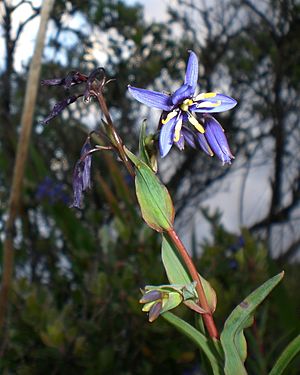Stypandra facts for kids
Quick facts for kids Stypandra |
|
|---|---|
 |
|
| Stypandra glauca | |
| Scientific classification |
|
| Kingdom: | Plantae |
| Clade: | Tracheophytes |
| Clade: | Angiosperms |
| Clade: | Monocots |
| Order: | Asparagales |
| Family: | Asphodelaceae |
| Subfamily: | Hemerocallidoideae |
| Genus: | Stypandra |
| Species | |
|
See text. |
|
Stypandra is a small group of plants. These plants grow from special underground stems called rhizomes. Because they are perennials, they live for more than two years. Stypandra plants belong to the Asphodelaceae family. This family also includes well-known plants like Aloe vera and daylilies. You can find Stypandra growing naturally in Australia and New Caledonia.
Contents
Discovering Stypandra Plants
Stypandra plants are known for their unique way of growing. They spread using their rhizomes, which are like underground roots. These rhizomes help the plant store food and survive for many years. This makes them very tough and able to grow back each season.
Where Stypandra Grows
These interesting plants are native to two main areas. Most of them are found across different parts of Australia. You can also find some species growing on the islands of New Caledonia. This shows they can adapt to various environments.
Types of Stypandra
Currently, scientists recognize two main types, or species, of Stypandra. Each one has its own special features.
Stypandra Glauca
- Stypandra glauca is also known by common names like Nodding Blue Lily or Blind Grass.
- This species is found in many parts of Australia. It also grows in New Caledonia.
- It is one of the more widespread types of Stypandra.
Stypandra Jamesii
- Stypandra jamesii was discovered by a scientist named Hopper.
- This particular species grows only in Western Australia.
- It is a unique plant found in that specific region.
See also
 In Spanish: Stypandra para niños
In Spanish: Stypandra para niños

